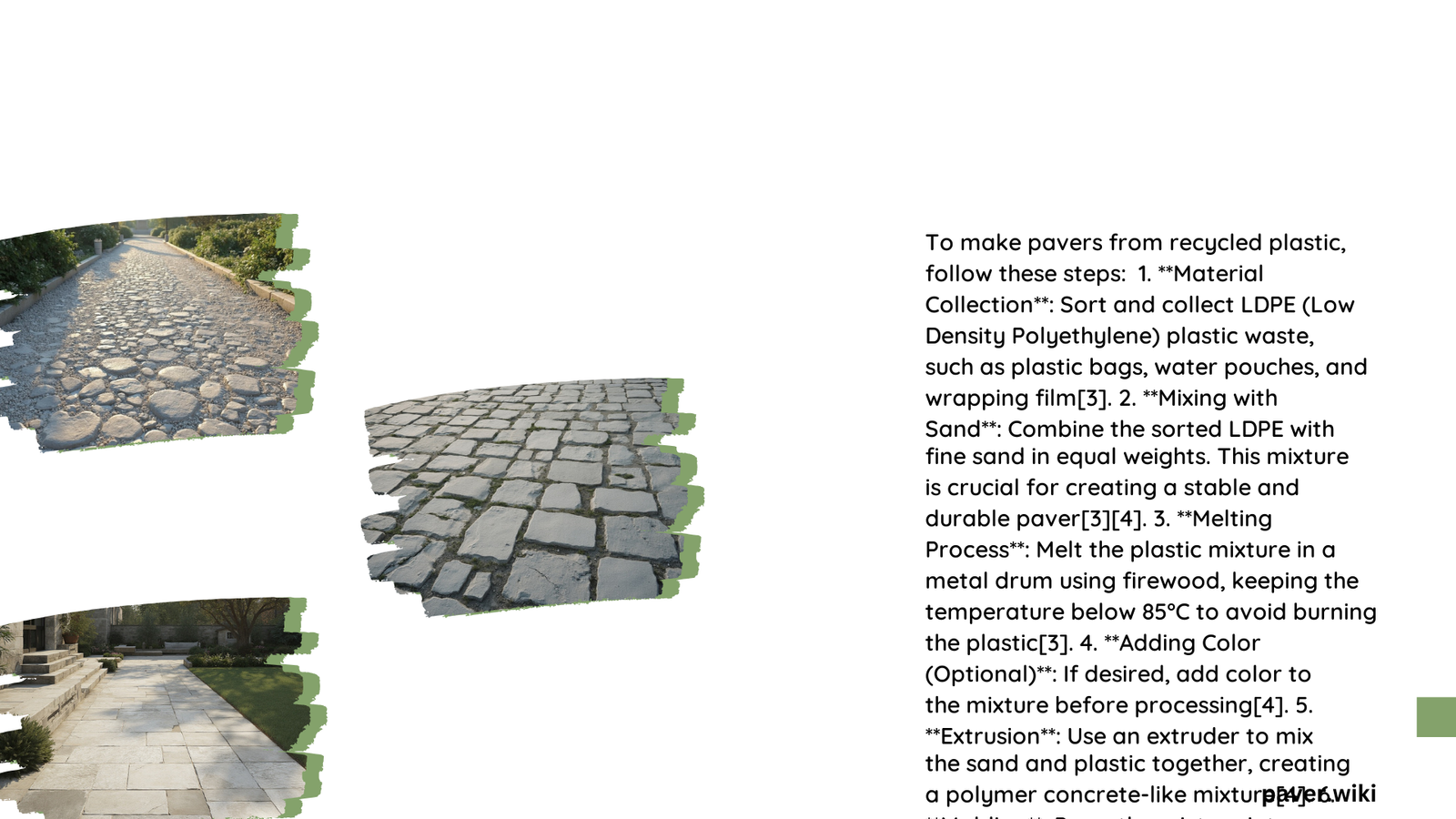Recycled plastic pavers offer an innovative solution to plastic waste management and sustainable construction. This process involves transforming discarded plastic into durable, eco-friendly pavers for roads, walkways, and other surfaces. By repurposing plastic waste, we can reduce landfill burden, lower construction costs, and create long-lasting infrastructure materials.
What Materials Are Used in Making Recycled Plastic Pavers?
The production of recycled plastic pavers primarily utilizes:
- High-Density Polyethylene (HDPE)
- Low-Density Polyethylene (LDPE)
- Linear Low-Density Polyethylene (LLDPE)
- Polypropylene (PP)
These plastics are often mixed with other materials to enhance strength and durability:
- M-sand (manufactured sand)
- Aggregate
- Bitumen (for asphalt mixtures)
The optimal mix ratio for road paver blocks is typically 20% plastic waste to 80% M-sand. This combination provides superior compressive strength compared to other ratios.
How Is the Production Process Carried Out?

The step-by-step process for making pavers from recycled plastic involves:
- Collection and Processing:
- Gather plastic waste
- Shred into smaller pieces
-
Clean and sort by type and quality
-
Mixing:
- Combine shredded plastic with M-sand or aggregate
-
For asphalt mixtures, add bitumen
-
Molding:
-
Pour the mixture into paver molds
-
Compaction:
-
Use hydraulic press or compaction machinery to achieve desired density
-
Curing:
- Allow pavers to cure under controlled conditions
- Curing time varies based on mixture and environment
What Are the Benefits of Using Plastic Pavers?
Plastic pavers offer numerous advantages:
- Cost-Effective: Lower production costs due to recycled materials
- Durable: Can last up to 50% longer than conventional pavements
- Low Maintenance: Resistant to water damage, cracking, and potholes
- Environmentally Friendly: Repurposes significant amounts of plastic waste
| Benefit | Description |
|---|---|
| Lifespan | Up to 50% longer than traditional materials |
| Waste Reduction | One ton of mix = 80,000 plastic bottles |
| Road Coverage | 1 km of road = 750,000 plastic bags |
How Can You Make DIY Plastic Paver Molds?
Creating your own plastic paver molds is possible with these steps:
- Design:
- Choose dimensions (e.g., 200x100x60 mm or 300x150x80 mm)
-
Select mold material (steel, aluminum, or durable plastic)
-
Fabrication:
- Construct mold based on design
-
Ensure durability for compaction process
-
Preparation:
- Apply release agent to prevent sticking
-
Clean mold thoroughly
-
Usage:
- Fill with plastic and M-sand mixture
- Compact using hydraulic press or hand compactor
- Allow to cure before removing
What Are the Environmental Impacts of Plastic Pavers?
Plastic pavers significantly contribute to waste reduction:
- Potential to absorb up to 40% of municipal plastic waste if widely adopted
- Reduces landfill burden
- Lowers demand for virgin materials in construction
Moreover, the durability of plastic pavers means less frequent replacement, further reducing environmental impact over time.
How Do Plastic Pavers Compare to Traditional Materials?
Plastic pavers offer several advantages over traditional materials:
- Temperature Resistance: Better tolerance to wide temperature swings
- Water Resistance: Less susceptible to water damage
- Crack Resistance: More flexible, reducing likelihood of cracking
- Pothole Prevention: Structure resists pothole formation
These properties contribute to a longer lifespan and reduced maintenance needs compared to conventional paving materials.
What Are the Challenges in Producing Plastic Pavers?
While promising, the production of plastic pavers faces some challenges:
- Quality Control: Ensuring consistent quality of recycled plastic input
- Processing Costs: Initial setup for processing and production can be expensive
- Regulatory Approval: Meeting construction standards and regulations
- Public Perception: Overcoming skepticism about using recycled materials in infrastructure
Ongoing research and development are addressing these challenges to improve the viability and adoption of plastic pavers.
How Can Plastic Pavers Contribute to Sustainable Urban Development?
Plastic pavers play a crucial role in sustainable urban development:
- Waste Management: Provides a solution for plastic waste utilization
- Resource Efficiency: Reduces demand for new raw materials
- Urban Heat Island Effect: Can be designed to reflect more sunlight, reducing heat absorption
- Stormwater Management: Permeable designs can improve water drainage
By incorporating plastic pavers into urban planning, cities can make significant strides towards sustainability goals.
Making pavers from recycled plastic represents a innovative approach to both waste management and sustainable construction. As technology advances and adoption increases, we can expect to see more widespread use of these eco-friendly building materials in our roads, walkways, and urban spaces.
References:
1. https://www.mdpi.com/2673-4109/4/4/58
2. https://e360.yale.edu/features/how-paving-with-plastic-could-make-a-dent-in-the-global-waste-problem
3. https://www.asphaltmagazine.com/recycled-plastics-in-asphalt-pavements/
